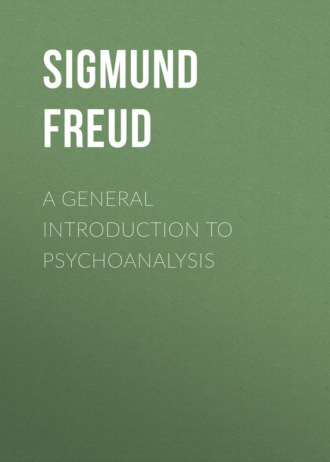 полная версия
полная версияA General Introduction to Psychoanalysis
Let us now piece together these fragments to see what a short and impeded psychoanalysis can nevertheless contribute to the understanding of this case. It is assumed of course that our inquiries were carefully conducted, a point which I cannot at this place submit to your judgment. In the first place, the obsession becomes no longer nonsensical nor incomprehensible, it is full of meaning, well motivated and an integral part of the patient's emotional experience. Secondly, it is a necessary reaction toward an unconscious psychological process, revealed in other ways, and it is to this very circumstance that it owes its obsessional nature, that is, its resistance to arguments based on logic or fact. In itself the obsession is something wished for, a kind of consolation. Finally, the experiences underlying the condition are such as unmistakably determine an obsession of jealousy and no other. You will also recognize the part played by the two important analogies in the analysis of the symptomatic act with reference to its meaning and intent and also to its relation to an unconscious factor in the situation.
Naturally, we have not yet answered all the questions which may be put on the basis of this case. Rather the case bristles with further problems of a kind which we have not yet been able to solve in any way, and of others which could not be solved because of the disadvantage of the circumstances under which we were working. For example: why is this happily married woman open to an infatuation for her son-in-law, and why does the relief which could have been obtained in other ways come to her by way of this mirror-image, this projection of her own condition upon her husband? I trust you will not think that it is idle and wanton to open such problems. Already we have much material at our disposal for their possible solution. This woman is in that critical age when her sexual needs undergo a sudden and unwelcome exaggeration. This might in itself be sufficient. In addition, her good and faithful mate may for many years have been lacking in that sufficient sexual capacity which the well-preserved woman needs for her satisfaction. We have learned by experience to know that those very men whose faithfulness is thus placed beyond a doubt are most gentle in their treatment of their wives and unusually forbearing toward their nervous complaints. Furthermore, the fact that it was just the young husband of a daughter who became the object of her abnormal infatuation is by no means insignificant. A strong erotic attachment to the daughter, which in the last analysis leads back to the mother's sexual constitution, will often find a way to live on under such a disguise. May I perhaps remind you in this connection that the relationship between mother and son-in-law has seemed particularly delicate since all time and is one which among primitive peoples gave rise to very powerful taboos and avoidances.37 It often transgresses our cultural standards positively as well as negatively. I cannot tell you of course which of these three factors were at work in our case; whether two of them only, or whether all of them coöperated, for as you know I did not have the opportunity to continue the analysis beyond two hours.
I realize at this point, ladies and gentlemen, that I have been speaking entirely of things for which your understanding was not prepared. I did this in order to carry through the comparison of psychiatry and psychoanalysis. May I now ask one thing of you? Have you noticed any contradiction between them? Psychiatry does not apply the technical methods of psychoanalysis, and neglects to look for any significance in the content of the obsession. Instead of first seeking out more specific and immediate causes, psychiatry refers us to the very general and remote source – heredity. But does this imply a contradiction, a conflict between them? Do they not rather supplement one another? For does the hereditary factor deny the significance of the experience, is it not rather true that both operate together in the most effective way? You must admit that there is nothing in the nature of psychiatric work which must repudiate psychoanalytic research. Therefore, it is the psychiatrists who oppose psychoanalysis, not psychiatry itself. Psychoanalysis stands in about the same relation to psychiatry as does histology to anatomy. The one studies the outer forms of organs, the other the closer structure of tissues and cells. A contradiction between two types of study, where one simplifies the other, is not easily conceivable. You know that anatomy to-day forms the basis of scientific medicine, but there was a time when the dissection of human corpses to learn the inner structure of the body was as much frowned upon as the practice of psychoanalysis, which seeks to ascertain the inner workings of the human soul, seems proscribed to-day. And presumably a not too distant time will bring us to the realization that a psychiatry which aspires to scientific depth is not possible without a real knowledge of the deeper unconscious processes in the psychic life.
Perhaps this much-attacked psychoanalysis has now found some friends among you who are anxious to see it justify itself as well from another aspect, namely, the therapeutic side. You know that the therapy of psychiatry has hitherto not been able to influence obsessions. Can psychoanalysis perhaps do so, thanks to its insight into the mechanism of these symptoms? No, ladies and gentlemen, it cannot; for the present at least it is just as powerless in the face of these maladies as every other therapy. We can understand what it was that happened within the patient, but we have no means of making the patient himself understand this. In fact, I told you that I could not extend the analysis of the obsession beyond the first steps. Would you therefore assert that analysis is objectionable in such cases because it remains without result? I think not. We have the right, indeed we have the duty to pursue scientific research without regard to an immediate practical effect. Some day, though we do not know when or where, every little scrap of knowledge will have been translated into skill, even into therapeutic skill. If psychoanalysis were as unsuccessful in all other forms of nervous and psychological disease as it is in the case of the obsession, it would nevertheless remain fully justified as an irreplaceable method of scientific research. It is true that we would then not be in a position to practice it, for the human subjects from which we must learn, live and will in their own right; they must have motives of their own in order to assist in the work, but they would deny themselves to us. Therefore let me conclude this session by telling you that there are comprehensive groups of nervous diseases concerning which our better understanding has actually been translated into therapeutic power; moreover, that in disturbances which are most difficult to reach we can under certain conditions secure results which are second to none in the field of internal therapeutics.
SEVENTEENTH LECTURE
GENERAL THEORY OF THE NEUROSES
The Meaning of the SymptomsIN the last lecture I explained to you that clinical psychiatry concerns itself very little with the form under which the symptoms appear or with the burden they carry, but that it is precisely here that psychoanalysis steps in and shows that the symptom carries a meaning and is connected with the experience of the patient. The meaning of neurotic symptoms was first discovered by J. Breuer in the study and felicitous cure of a case of hysteria which has since become famous (1880-82). It is true that P. Janet independently reached the same result; literary priority must in fact be accorded to the French scholar, since Breuer published his observations more than a decade later (1893-95) during his period of collaboration with me. On the whole it may be of small importance to us who is responsible for this discovery, for you know that every discovery is made more than once, that none is made all at once, and that success is not meted out according to deserts. America is not named after Columbus. Before Breuer and Janet, the great psychiatrist Leuret expressed the opinion that even for the deliria of the insane, if we only understood how to interpret them, a meaning could be found. I confess that for a considerable period of time I was willing to estimate very highly the credit due to P. Janet in the explanation of neurotic symptoms, because he saw in them the expression of subconscious ideas (idées inconscientes) with which the patients were obsessed. But since then Janet has expressed himself most conservatively, as though he wanted to confess that the term "subconscious" had been for him nothing more than a mode of speech, a shift, "une façon de parler," by the use of which he had nothing definite in mind. I now no longer understand Janet's discussions, but I believe that he has needlessly deprived himself of high credit.
The neurotic symptoms then have their meaning just like errors and the dream, and like these they are related to the lives of the persons in whom they appear. The importance of this insight into the nature of the symptom can best be brought home to you by way of examples. That it is borne out always and in all cases, I can only assert, not prove. He who gathers his own experience will be convinced of it. For certain reasons, however, I shall draw my instances not from hysteria, but from another fundamentally related and very curious neurosis concerning which I wish to say a few introductory words to you. This so-called compulsion neurosis is not so popular as the widely known hysteria; it is, if I may use the expression, not so noisily ostentatious, behaves more as a private concern of the patient, renounces bodily manifestations almost entirely and creates all its symptoms psychologically. Compulsion neurosis and hysteria are those forms of neurotic disease by the study of which psychoanalysis has been built up, and in whose treatment as well the therapy celebrates its triumphs. Of these the compulsion neurosis, which does not take that mysterious leap from the psychic to the physical, has through psychoanalytic research become more intimately comprehensible and transparent to us than hysteria, and we have come to understand that it reveals far more vividly certain extreme characteristics of the neuroses.
The chief manifestations of compulsion neurosis are these: the patient is occupied by thoughts that in reality do not interest him, is moved by impulses that appear alien to him, and is impelled to actions which, to be sure, afford him no pleasure, but the performance of which he cannot possibly resist. The thoughts may be absurd in themselves or thoroughly indifferent to the individual, often they are absolutely childish and in all cases they are the result of strained thinking, which exhausts the patient, who surrenders himself to them most unwillingly. Against his will he is forced to brood and speculate as though it were a matter of life or death to him. The impulses, which the patient feels within himself, may also give a childish or ridiculous impression, but for the most part they bear the terrifying aspect of temptations to fearful crimes, so that the patient not only denies them, but flees from them in horror and protects himself from actual execution of his desires through inhibitory renunciations and restrictions upon his personal liberty. As a matter of fact he never, not a single time, carries any of these impulses into effect; the result is always that his evasion and precaution triumph. The patient really carries out only very harmless trivial acts, so-called compulsive acts, for the most part repetitions and ceremonious additions to the occupations of every-day life, through which its necessary performances – going to bed, washing, dressing, walking – become long-winded problems of almost insuperable difficulty. The abnormal ideas, impulses and actions are in nowise equally potent in individual forms and cases of compulsion neurosis; it is the rule, rather, that one or the other of these manifestations is the dominating factor and gives the name to the disease; that all these forms, however, have a great deal in common is quite undeniable.
Surely this means violent suffering. I believe that the wildest psychiatric phantasy could not have succeeded in deriving anything comparable, and if one did not actually see it every day, one could hardly bring oneself to believe it. Do not think, however, that you give the patient any help when you coax him to divert himself, to put aside these stupid ideas and to set himself to something useful in the place of his whimsical occupations. This is just what he would like of his own accord, for he possesses all his senses, shares your opinion of his compulsion symptoms, in fact volunteers it quite readily. But he cannot do otherwise; whatever activities actually are released under compulsion neurosis are carried along by a driving energy, such as is probably never met with in normal psychic life. He has only one remedy – to transfer and change. In place of one stupid idea he can think of a somewhat milder absurdity, he can proceed from one precaution and prohibition to another, or carry through another ceremonial. He may shift, but he cannot annul the compulsion. One of the chief characteristics of the sickness is the instability of the symptoms; they can be shifted very far from their original form. It is moreover striking that the contrasts present in all psychological experience are so very sharply drawn in this condition. In addition to the compulsion of positive and negative content, an intellectual doubt makes itself felt that gradually attacks the most ordinary and assured certainties. All these things merge into steadily increasing uncertainty, lack of energy, curtailment of personal liberty, despite the fact that the patient suffering from compulsion neurosis is originally a most energetic character, often of extraordinary obstinacy, as a rule intellectually gifted above the average. For the most part he has attained a desirable stage of ethical development, is overconscientious and more than usually correct. You can imagine that it takes no inconsiderable piece of work to find one's way through this maze of contradictory characteristics and symptoms. Indeed, for the present our only object is to understand and to interpret some symptoms of this disease.
Perhaps in reference to our previous discussions, you would like to know the position of present-day psychiatry to the problems of the compulsion neurosis. This is covered in a very slim chapter. Psychiatry gives names to the various forms of compulsion, but says nothing further concerning them. Instead it emphasizes the fact that those who show these symptoms are degenerates. That yields slight satisfaction, it is an ethical judgment, a condemnation rather than an explanation. We are led to suppose that it is in the unsound that all these peculiarities may be found. Now we do believe that persons who develop such symptoms must differ fundamentally from other people. But we would like to ask, are they more "degenerate" than other nervous patients, those suffering, for instance, from hysteria or other diseases of the mind? The characterization is obviously too general. One may even doubt whether it is at all justified, when one learns that such symptoms occur in excellent men and women of especially great and universally recognized ability. In general we glean very little intimate knowledge of the great men who serve us as models. This is due both to their own discretion and to the lying propensities of their biographers. Sometimes, however, a man is a fanatic disciple of truth, such as Emile Zola, and then we hear from him the strange compulsion habits from which he suffered all his life.38
Psychiatry has resorted to the expedient of speaking of "superior degenerates." Very well – but through psychoanalysis we have learned that these peculiar compulsion symptoms may be permanently removed just like any other disease of normal persons. I myself have frequently succeeded in doing this.
I will give you two examples only of the analysis of compulsion symptoms, one, an old observation, which cannot be replaced by anything more complete, and one a recent study. I am limiting myself to such a small number because in an account of this nature it is necessary to be very explicit and to enter into every detail.
A lady about thirty years old suffered from the most severe compulsions. I might indeed have helped her if caprice of fortune had not destroyed my work – perhaps I will yet have occasion to tell you about it. In the course of each day the patient often executed, among others, the following strange compulsive act. She ran from her room into an adjoining one, placed herself in a definite spot beside a table which stood in the middle of the room, rang for her maid, gave her a trivial errand to do, or dismissed her without more ado, and then ran back again. This was certainly not a severe symptom of disease, but it still deserved to arouse curiosity. Its explanation was found, absolutely without any assistance on the part of the physician, in the very simplest way, a way to which no one can take exception. I hardly know how I alone could have guessed the meaning of this compulsive act, or have found any suggestion toward its interpretation. As often as I had asked the patient: "Why do you do this? Of what use is it?" she had answered, "I don't know." But one day after I had succeeded in surmounting a grave ethical doubt of hers she suddenly saw the light and related the history of the compulsive act. More than ten years prior she had married a man far older than herself, who had proved impotent on the bridal night. Countless times during the night he had run from his room to hers to repeat the attempt, but each time without success. In the morning he said angrily: "It is enough to make one ashamed before the maid who does the beds," and took a bottle of red ink that happened to be in the room, and poured its contents on the sheet, but not on the place where such a stain would have been justifiable. At first I did not understand the connection between this reminiscence and the compulsive act in question, for the only agreement I could find between them was in the running from one room into another, – possibly also in the appearance of the maid. Then the patient led me to the table in the second room and let me discover a large spot on the cover. She explained also that she placed herself at the table in such a way that the maid could not miss seeing the stain. Now it was no longer possible to doubt the intimate relation of the scene after her bridal night and her present compulsive act, but there were still a number of things to be learned about it.
In the first place, it is obvious that the patient identifies herself with her husband, she is acting his part in her imitation of his running from one room into the other. We must then admit – if she holds to this role – that she replaces the bed and sheet by table and cover. This may seem arbitrary, but we have not studied dream symbolism in vain. In dreams also a table which must be interpreted as a bed, is frequently seen. "Bed and board" together represent married life, one may therefore easily be used to represent the other.
The evidence that the compulsive act carries meaning would thus be plain; it appears as a representation, a repetition of the original significant scene. However, we are not forced to stop at this semblance of a solution; when we examine more closely the relation between these two people, we shall probably be enlightened concerning something of wider importance, namely, the purpose of the compulsive act. The nucleus of this purpose is evidently the summoning of the maid; to her she wishes to show the stain and refute her husband's remark: "It is enough to shame one before the maid." He – whose part she is playing – therefore feels no shame before the maid, hence the stain must be in the right place. So we see that she has not merely repeated the scene, rather she has amplified it, corrected it and "turned it to the good." Thereby, however, she also corrects something else, – the thing which was so embarrassing that night and necessitated the use of the red ink – impotence. The compulsive act then says: "No, it is not true, he did not have to be ashamed before the maid, he was not impotent." After the manner of a dream she represents the fulfillment of this wish in an overt action, she is ruled by the desire to help her husband over that unfortunate incident.
Everything else that I could tell you about this case supports this clue more specifically; all that we otherwise know about her tends to strengthen this interpretation of a compulsive act incomprehensible in itself. For years the woman has lived separated from her husband and is struggling with the intention to obtain a legal divorce. But she is by no means free from him; she forces herself to remain faithful to him, she retires from the world to avoid temptation; in her imagination she excuses and idealizes him. The deepest secret of her malady is that by means of it she shields her husband from malicious gossip, justifies her separation from him, and renders possible for him a comfortable separate life. Thus the analysis of a harmless compulsive act leads to the very heart of this case and at the same time reveals no inconsiderable portion of the secret of the compulsion neurosis in general. I shall be glad to have you dwell upon this instance, as it combines conditions that one can scarcely demand in other cases. The interpretation of the symptoms was discovered by the patient herself in one flash, without the suggestion or interference of the analyst. It came about by the reference to an experience, which did not, as is usually the case, belong to the half-forgotten period of childhood, but to the mature life of the patient, in whose memory it had remained unobliterated. All the objections which critics ordinarily offer to our interpretation of symptoms fail in this case. Of course, we are not always so fortunate.
And one thing more! Have you not observed how this insignificant compulsive act initiated us into the intimate life of the invalid? A woman can scarcely relate anything more intimate than the story of her bridal night, and is it without further significance that we just happened to come on the intimacies of her sexual life? It might of course be the result of the selection I have made in this instance. Let us not judge too quickly and turn our attention to the second instance, one of an entirely different kind, a sample of a frequently occurring variety, namely, the sleep ritual.
A nineteen-year old, well-developed, gifted girl, an only child, who was superior to her parents in education and intellectual activity, had been wild and mischievous in her childhood, but has become very nervous during the last years without any apparent outward cause. She is especially irritable with her mother, always discontented, depressed, has a tendency toward indecision and doubt, and is finally forced to confess that she can no longer walk alone on public squares or wide thoroughfares. We shall not consider at length her complicated condition, which requires at least two diagnoses – agoraphobia and compulsion neurosis. We will dwell only upon the fact that this girl has also developed a sleep ritual, under which she allows her parents to suffer much discomfort. In a certain sense, we may say that every normal person has a sleep ritual, in other words that he insists on certain conditions, the absence of which hinders him from falling asleep; he has created certain observances by which he bridges the transition from waking to sleeping and these he repeats every evening in the same manner. But everything that the healthy person demands in order to obtain sleep is easily understandable and, above all, when external conditions necessitate a change, he adapts himself easily and without loss of time. But the pathological ritual is rigid, it persists by virtue of the greatest sacrifices, it also masks itself with a reasonable justification and seems, in the light of superficial observation, to differ from the normal only by exaggerated pedantry. But under closer observation we notice that the mask is transparent, for the ritual covers intentions that go far beyond this reasonable justification, and other intentions as well that are in direct contradiction to this reasonable justification. Our patient cites as the motive of her nightly precautions that she must have quiet in order to sleep; therefore she excludes all sources of noise. To accomplish this, she does two things: the large clock in her room is stopped, all other clocks are removed; not even the wrist watch on her night-table is suffered to remain. Flowerpots and vases are placed on her desk so that they cannot fall down during the night, and in breaking disturb her sleep. She knows that these precautions are scarcely justifiable for the sake of quiet; the ticking of the small watch could not be heard even if it should remain on the night-table, and moreover we all know that the regular ticking of a clock is conducive to sleep rather than disturbing. She does admit that there is not the least probability that flowerpots and vases left in place might of their own accord fall and break during the night. She drops the pretense of quiet for the other practice of this sleep ritual. She seems on the contrary to release a source of disturbing noises by the demand that the door between her own room and that of her parents remain half open, and she insures this condition by placing various objects in front of the open door. The most important observances concern the bed itself. The large pillow at the head of the bed may not touch the wooden back of the bed. The small pillow for her head must lie on the large pillow to form a rhomb; she then places her head exactly upon the diagonal of the rhomb. Before covering herself, the featherbed must be shaken so that its foot end becomes quite flat, but she never omits to press this down and redistribute the thickness.











